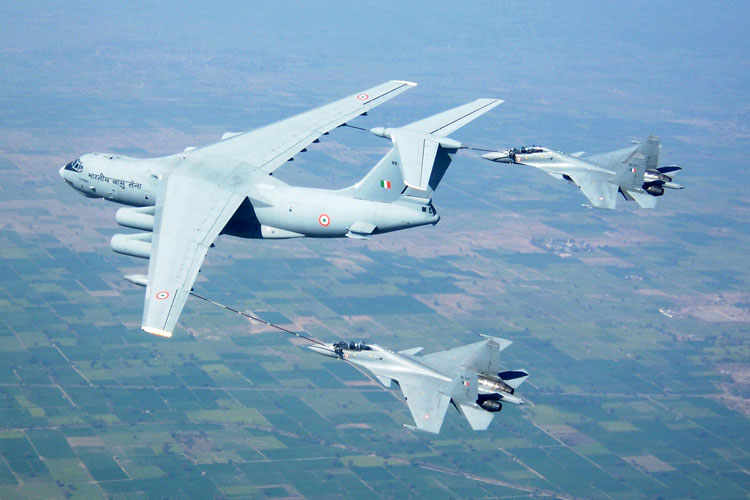Force multipliers for the IAF are a necessity that the government can no longer drag its feet on
 AVM Manmohan Bahadur (retd)
AVM Manmohan Bahadur (retd)
The so-called ‘hollowness’ of the armed forces has drawn a lot of traction in the press. There is some truth to this but only with respect to certain items of the combat inventory; however, to say that the services do not have the narrative under control is hyperbole.
When it comes to the Indian Air Force (IAF), the talk centres around the depleting fighter fleet due to phasing out of the MiG-21/27 fleet in the coming decade. Though the Tejas Mk1 is being inducted (Tejas Mk 1A, which the IAF wants, is still at least five years away) and 36 Rafales would start flying in after three years, the numbers would still go down unless another type (Gripen/F-16) is bought.
But it needs to be remembered that the potency of the combat fleet, and that includes transport aircraft and helicopters too, depends a great deal on supporting assets like the Flight Refuelling Aircraft (FRA), Airborne Warning and Control Systems (AWACS) and Unmanned Aerial Vehicles (UAV), which actually are force multipliers in their own right. They are important cogs in any force packaging and their availability, unfortunately, has not drawn the attention that is deserved. This article discusses the state of force multipliers of the IAF.
Flight Refuelling Aircraft
The Flight Refuelling Aircraft (FRA) were inducted into the IAF in 2003 when No 78 Squadron was raised at Air Force Station Agra with IL-78MKI aircraft. The aircraft is basically an IL-76 airframe modified with an Israeli probe and drogue refuelling system. In quick time, the Squadron became operational with its six IL-78s and started training with Su-30, Mirage and Jaguar fighters. The in-flight refuelling capability of these fighter aircraft, which was lying unutilised till then, now extended the flight ranges available to the strike planners of the IAF.
The Sea Harriers (now phased out) and MiG-29Ks of the Indian Navy soon joined in and the operational crew of the two services started flying long duration sorties with multiple in-flight refuelling being an integral part of the air tasking orders. However, the numbers of the FRA proved grossly inadequate and the IAF put up its vision of having an augmented strength of 16 FRAs to cater to the fast changing security scenario.
In a keenly contested fly-off in 2008-09 between the IL-78 and Airbus-330 MRTT (Multi Role Tanker Transport), the latter beat the former in the field of life cycle costing and was recommended for induction. This was shot down by the ministry of finance due ‘high cost.’ The request for proposal was re-floated in 2010 and in another evaluation of the same two contenders the Airbus-330 MRTT again came out winner. This, after another torturous round of negotiations, was shelved in May 2016. Once again the logic for lower life cycle cost not finding favour in comparison to the low initial purchase price of the Russian machine!
The field is once again wide open but the loss has been that of the IAF whose training has suffered due to issues of low serviceability of the IL-78s. A new player has now reportedly entered the arena, and that is Boeing with its KC-46A tanker that is based on the Boeing-767 civil airliner. The advantage of both the western aircraft is that their fuselage space is not taken up by fuel tanks, which is the case with the IL-78. Thus, both the KC-46A and the A330 MRTT can take along the ground support party to service the fighters on their deployment, unlike in the case of the IL-78, where a separate IL-76 has to carry maintenance crew for long deployments — like moves to Europe for Exercise Garud and Indradhanush and to the US for Red Flag.
Additionally, western aero-engines are very fuel efficient unlike the Russian ones, and hence the quantity of fuel available to be dispensed by the KC-46 and A330 MRTT is much more than that of the IL-78; while the former carry around 100 to 110 tonnes of fuel, the IL-78 has 85 tonnes to dispense. There are many more advantages including the ease of maintenance, which itself is spaced out much more than the Russian aircraft, and the long total life of western aviation products.
Recently, there have been reports that the IAF is going-in for an upgrade of the IL-78MKI to IL-78MK-90 standard where-in it would be re-engined with the PS-90A aero-engines; this would be a welcome step as the PS-90A engine is modern with electronic controls and is much more fuel efficient, thus increasing the fuel available to dispense to fighter aircraft.
There are also reports that the deal for the FRA would be through the government-to government (G2G) route, just like the Rafale purchase has happened. With the improvement of Indo-US ties, is this an indication of the Boeing getting an upper hand? Only time will tell which aircraft will finally enter IAF inventory, but the fact remains that the air force is in urgent need of additional FRA for its op plans to be executed efficiently, if the balloon goes up.

AWACS
The operational necessity of Airborne Warning and Control System (AWACS) cannot be underlined enough in modern warfare. Accordingly, the IAF has acquired three IL-76 based AWACS equipped with the Israeli Phalcon radar system. The fixed rotodome electronically scanned radars have proved to be very efficient and give the IAF an unmatched eye in the sky.
The AWACS would be integrated in the overall surveillance provided by the Integrated Air Command and Control System (IACCS) that the IAF is putting in place for gap free radar coverage of the nation’s airspace. The government has cleared the acquisition of two more IL-76 based and Phalcon radar equipped AWACS from Israel, following the same route as the earlier three.
There is another proposal called the AWACS (India) which involves integration of an indigenous radar on a heavy transport aircraft. The aircraft selected for this is the Airbus-330 and the radar is expected to flow out from the AEW&C system being made by the Centre for Airborne Systems (CABS), Bangalore. While two AWACS (India) aircraft have been cleared, the success of the project would see the numbers going up to eight.
The IAF is acquiring the Embraer-145 based AEW&C systems developed indigenously by CABS. The radar is an electronically scanned array mounted as a dorsal beam antenna on the Emb145 mother aircraft. At the time of writing this piece, the prototype phase is nearing completion and after successful testing, the system would be fitted on two other Emb-145s bought from Brazil.
Aerostat Radars
Radars mounted on aerostats tethered to ground but flying at altitudes of around 15,000 feet are force multipliers too — in more ways than one. The radars, having been elevated, can look deep into the adversary’s territory, thereby increasing the warning time for enemy in-coming strikes. With good ground clutter suppression software, the look down capability prevents the low, ground hugging, aircraft from sneaking in.
Additionally, the aerostats have on them Communication Intelligence (COMINT) and Signal Intelligence (SIGINT) equipment which, with their elevation, have a very long interception range. Thus, the package that is the aerostat radar, is a very valuable asset for Intelligence, Surveillance and Reconnaissance (ISR). India has two Israeli aerostats already operational and is supposedly going in for eight more systems for which a Request for Information (RFI) has been issued.
Unmanned Aerial Vehicles
India acquired the Searcher MK 1 UAVs from Israel Aircraft Industries (IAI) in the beginning of this century. Since then, Searcher II and Herons have entered the inventory and are being used extensively. The Indian Army and Navy, too, have acquired these UAVs and all three services have procured smaller tactical unmanned machines for ‘over the hill’ reconnaissance capability. The ISR capability that UAVs bring along have revolutionised operational planning and execution and these machines have generated a force multiplier effect of immense magnitude.
The absence of a human being in the cockpit ensures the execution of ‘dull, dirty and dangerous’ tasks and the demand for them has multiplied many fold over the years. The IAF, as per press reports, has contracted for armed Herons from Israel; this would accord a covert strike capability that is urgently needed in these times of sub-conventional conflicts originated from our neighbourhood. This has added importance as Pakistan has used its ‘indigenous’ Burraq armed UAV in its anti-terror operations on the Afghanistan border, while the Chinese have many of them, which in fact they are exporting too.
The holdings of UAVs in the IAF are limited and there is a large requirement for them. The DRDO’s Rustom II UAV is many years away and there appears to be no other option but to import them; the story is the same for the other two services also and a joint approach, to synergise acquisition and capability, is the need of the hour.
Tailpiece
The IACCS, once fully configured, would be the heart of the air defence network of IAF. All ground-based radars, both civil and military, would feed into the system, as would the AWACS and AEW&C. Taken together with data coming in from surveillance systems like UAVs and aerostats the integrated picture would give the air defence commander complete awareness of the air situation in his area. All operators plugged into the net would have a common operating picture of the area of interest and responsibility in real time. The force multiplier effect on planning and conduct of operations can well be imagined.
As India continues on its journey to a regional power status, the monies available to the defence sector would be hard to come by as the priority of the government would be the upliftment of its masses. Hence, it is essential that the costly assets acquired by the services, especially the IAF, live up to their combat potential.
Force multipliers are an important cog in achieving this; they come at a price, in fact, at a very high acquisition price tag, but the increment in the combat punch that accrues is many times higher. The planners in the ministry of defence (MoD) have to weigh the cost of procrastination as delayed decisions cost money; this would be seen in the case of the FRA, as and when they are approved. In the interim, the IAF would be well advised to judiciously regulate the use of the present force multipliers to keep the skills of aircrew finely honed for combat.
(The author is Distinguished Fellow at Centre for Air Power Studies, New Delhi)

